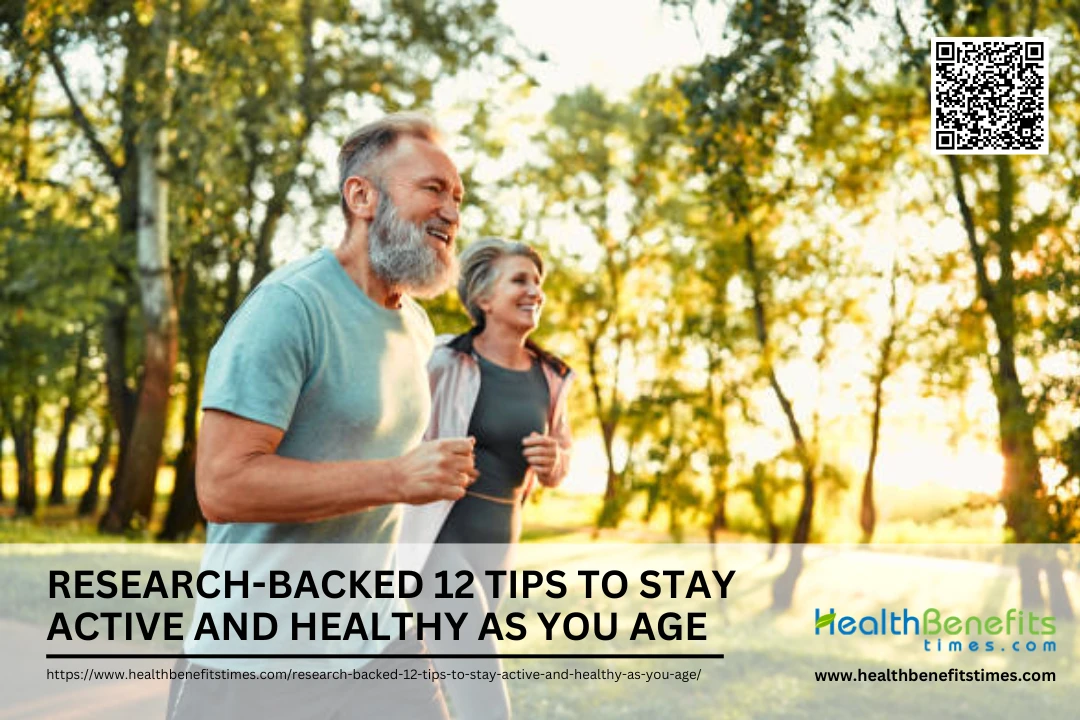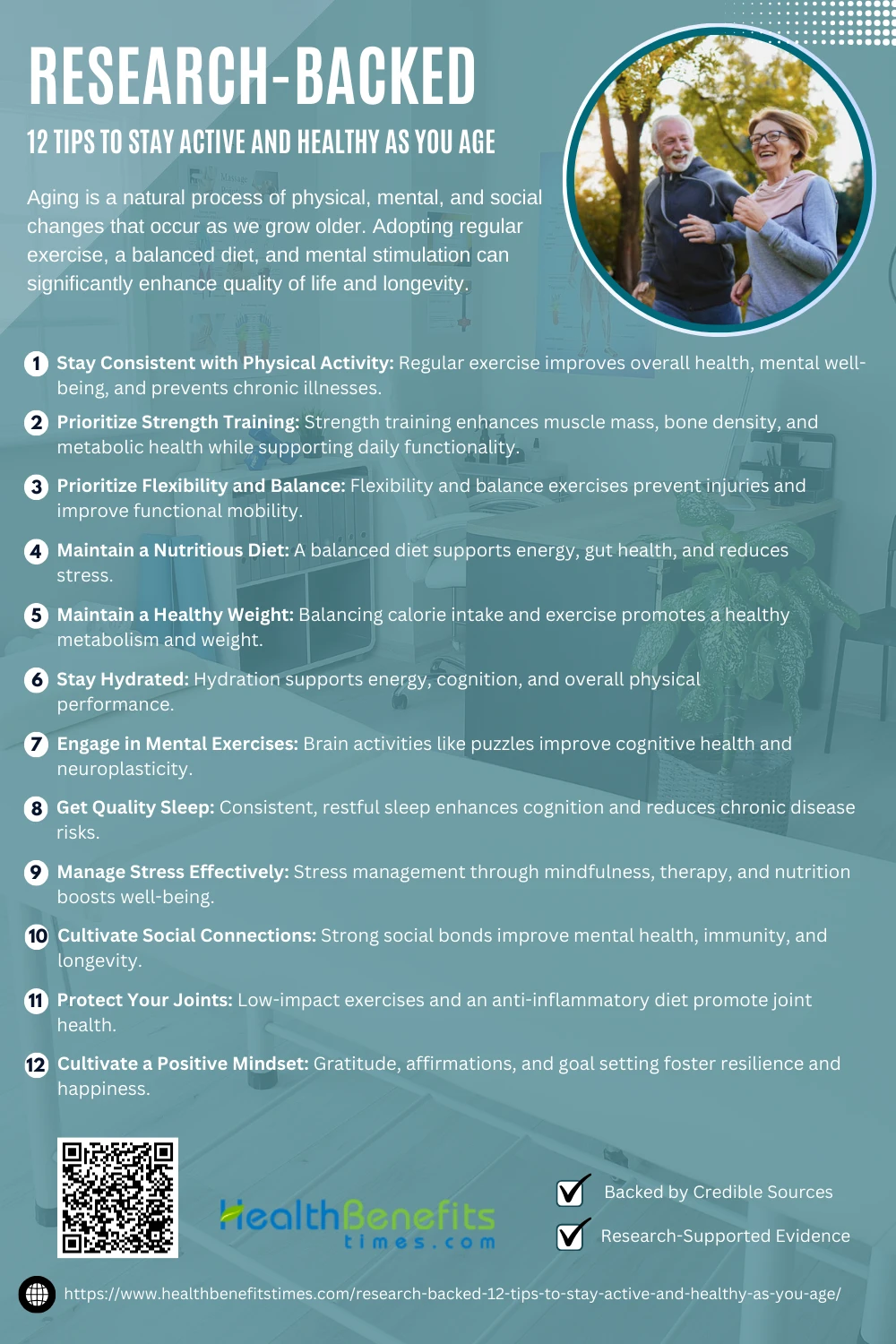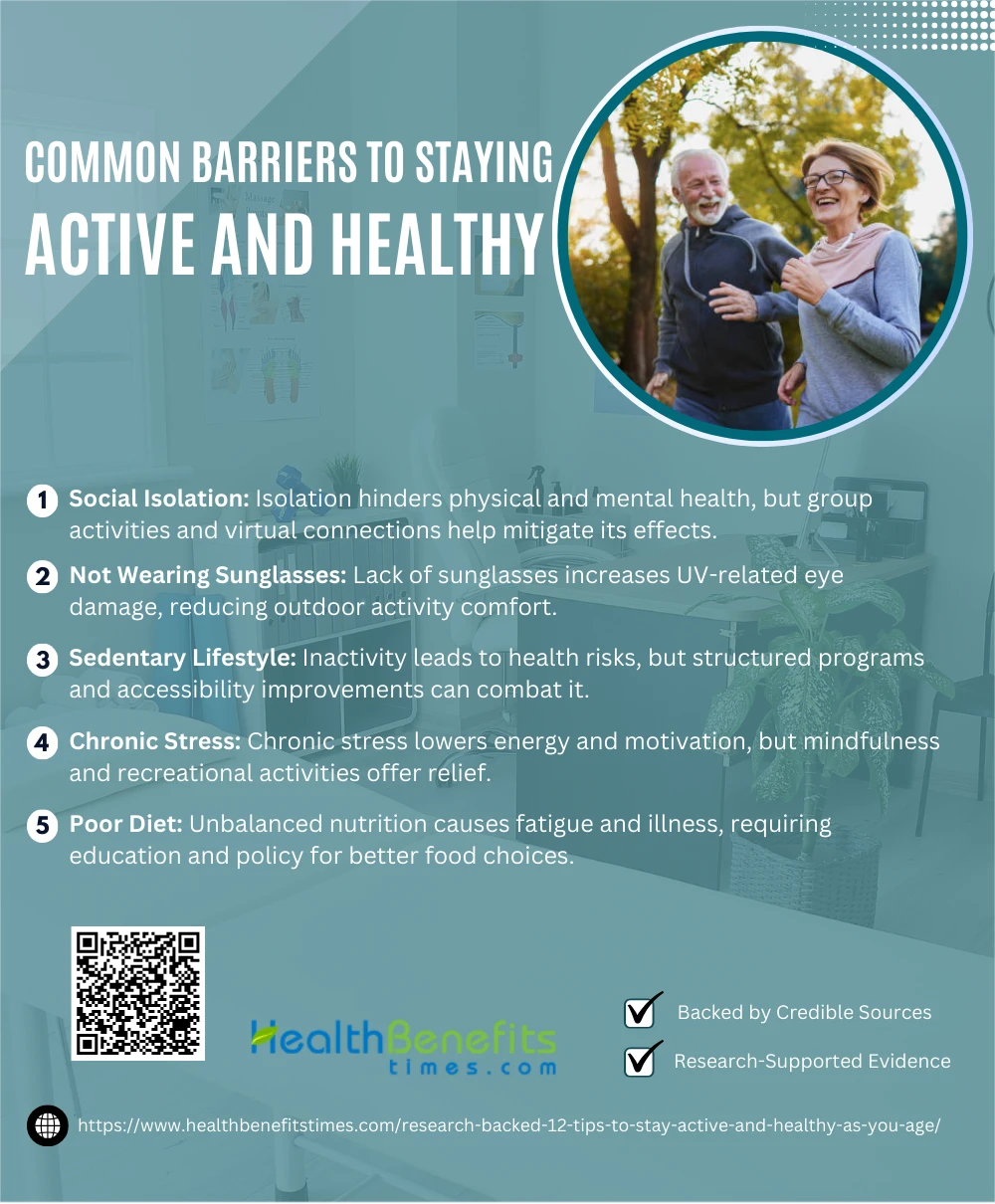- Aging is a natural process of physical, mental, and social changes that occur as we grow older.
- Adopting regular exercise, a balanced diet, and mental stimulation can significantly enhance quality of life and longevity.
- Small, consistent lifestyle changes help maintain independence, vitality, and overall well-being as you age.
 Aging refers to the natural process of biological, physical, and psychological changes that occur over time, leading to a gradual decline in bodily functions and adaptability (1). Staying active and maintaining good health as we age requires a proactive approach. Regular physical activity not only enhances mobility but also strengthens muscles, reduces the risk of chronic diseases, and promotes mental well-being. Cognitive health can be preserved through activities such as brain exercises, healthy eating, and mindfulness, all of which are supported by evidence-based studies (2). Furthermore, adherence to physical activity guidelines has shown to improve life quality significantly, especially when paired with adequate nutrition and rest (3). Strength training and high-intensity interval training (HIIT) are particularly beneficial for older adults, providing a sustainable path to maintain energy and bone health (4). Social connections, regular hydration, and preventive health measures round out these science-backed tips for thriving in later years (5).
Aging refers to the natural process of biological, physical, and psychological changes that occur over time, leading to a gradual decline in bodily functions and adaptability (1). Staying active and maintaining good health as we age requires a proactive approach. Regular physical activity not only enhances mobility but also strengthens muscles, reduces the risk of chronic diseases, and promotes mental well-being. Cognitive health can be preserved through activities such as brain exercises, healthy eating, and mindfulness, all of which are supported by evidence-based studies (2). Furthermore, adherence to physical activity guidelines has shown to improve life quality significantly, especially when paired with adequate nutrition and rest (3). Strength training and high-intensity interval training (HIIT) are particularly beneficial for older adults, providing a sustainable path to maintain energy and bone health (4). Social connections, regular hydration, and preventive health measures round out these science-backed tips for thriving in later years (5).
Research-Backed Tips for Staying Active and Healthy
Aging gracefully means staying active and healthy. These research-backed tips empower you to boost vitality, maintain independence, and enjoy a fulfilling, vibrant life as you age.
 1. Stay Consistent with Physical Activity
1. Stay Consistent with Physical Activity
Consistency in physical activity is key to long-term health benefits, including improved cardiovascular health, mental well-being, and weight management (6). Regular exercise enhances cognitive function (7), reduces the risk of chronic illnesses (8), and supports better sleep (9). High-intensity workouts like HIIT maximize benefits in shorter durations (4). Maintaining motivation through structured routines can sustain consistency (5). Interventions targeting sedentary behavior have proven effective (10).
2. Prioritize Strength Training
Prioritizing strength training offers numerous health benefits, including enhanced muscle mass, bone density, and metabolic function (11). Resistance exercises improve cardiovascular health while preventing muscle loss as you age (12). High-intensity workouts slow aging and boost physical performance (13). Strength training can also enhance mental health and energy levels (2). Consistency is key, as routine exercise strengthens daily functionality (14). Recovery strategies optimize long-term strength gains (15).
3. Prioritize Flexibility and Balance
Prioritizing strength training is essential for maintaining muscle mass, improving bone density, and enhancing metabolic health (11). Resistance exercises contribute to cardiovascular health and reduce risks of chronic diseases (12). High-intensity strength workouts improve physical endurance and slow down the aging process (13). Regular training also boosts energy levels and supports cognitive function (7). Effective recovery strategies enhance the benefits of consistent training (15). Integrating strength exercises fosters overall health (16).
4. Maintain a Nutritious Diet
Maintaining a nutritious diet is vital for staying active and healthy, as it supports energy levels, muscle function, and overall vitality (16). Incorporating nutrient-dense foods, such as fruits and vegetables, ensures optimal gut health (17). Balanced diets rich in vitamins C, B, and healthy fats promote hormonal harmony (18). Slow eating reduces caloric intake and supports healthy weight management (19). Proper nutrition lowers cortisol levels and reduces stress (20). Additionally, whole foods bolster cognitive health (12).
5. Maintain a Healthy Weight
Maintaining a healthy weight involves balancing calorie intake and physical activity to optimize metabolism and reduce fat accumulation (19). A nutrient-rich diet of whole foods aids in hormonal balance and prevents weight gain (21). Consistent physical activity helps burn calories and sustain energy (22). Supplements like vitamins B and C enhance fat metabolism (7). Limiting processed foods and prioritizing portion control also play key roles (23).
6. Stay Hydrated
Staying hydrated is essential for maintaining energy levels, regulating body temperature, and supporting cognitive function (23). Proper hydration improves metabolic processes and aids in physical performance (7). It also promotes mental clarity and emotional balance (24). Staying hydrated prevents dehydration-induced fatigue (25).
7. Engage in Mental Exercises
Engaging in mental exercises enhances brain function, reduces cognitive decline, and improves overall mental health. Studies emphasize the benefits of activities like puzzles, reading, and memory games to stimulate the brain and foster neuroplasticity. Regular participation in intellectually challenging tasks, as shown by 26, boosts cognitive resilience. Moreover, mindfulness practices and meditation can positively impact memory and attention (27). Brain-training exercises also mitigate risks of age-related conditions and improve focus (28).
8. Get Quality Sleep
Getting quality sleep is essential for maintaining energy and overall health. Studies show that prioritizing 7–9 hours of restful sleep supports cognitive function and reduces the risk of chronic diseases (29). A consistent sleep routine enhances sleep quality and reduces stress (30). Additionally, managing hormone levels through sleep is vital for well-being (31).
9. Manage Stress Effectively
Effectively managing stress is essential for maintaining physical and mental health. Techniques like mindfulness meditation significantly reduce cortisol levels and enhance emotional well-being. Cognitive-behavioral therapy (CBT) is another proven method to address stress-related disorders. Aromatherapy and music therapy also promote relaxation (29). Nutritional strategies, such as magnesium-rich diets, reduce stress-related symptoms (30). Journaling enhances self-awareness and reduces anxiety (31).
10. Cultivate Social Connections
Cultivating social connections is vital for maintaining physical and mental well-being, reducing stress, and enhancing longevity. Research demonstrates that strong social ties boost immune health and reduce the risk of chronic diseases. Engaging in group activities like volunteering or joining clubs fosters a sense of belonging. Socializing also promotes cognitive health, delaying cognitive decline (29). Participating in family meals nurtures intergenerational bonds (31).
11. Protect Your Joints
Protecting your joints is crucial for maintaining an active lifestyle and preventing long-term discomfort. Regular low-impact exercises like swimming and yoga improve joint flexibility while minimizing stress on cartilage. Anti-inflammatory diets, rich in omega-3 fatty acids, reduce joint pain. Supplements like glucosamine and chondroitin support joint health (32). Maintaining a healthy weight eases pressure on knees and hips (33). Sideways walking exercises enhance joint stability (34). Lastly, recovery techniques like foam rolling prevent stiffness (15).
12. Cultivate a Positive Mindset
Cultivating a positive mindset is essential for overall health and resilience. Practices like gratitude journaling improve mental well-being and reduce stress. Cognitive reframing helps individuals view challenges more constructively. Additionally, exercising outdoors boosts mood through exposure to nature (31). Affirmations foster self-confidence (29). Social connections enhance emotional support. Finally, setting achievable goals strengthens motivation (15).
Common Barriers to Staying Active and Healthy
Staying active and healthy can be challenging due to common barriers like time constraints, motivation, health issues, or lack of resources. Identifying these helps overcome them effectively.
 1. Social Isolation
1. Social Isolation
Social isolation poses a significant barrier to staying active and healthy, leading to mental health issues and reduced physical activity. Loneliness increases the risk of depression and chronic conditions (35). Engaging in group activities mitigates these effects (36). Regular social interactions improve mental resilience (37). Virtual connections during isolation maintain emotional health (38). Interventions like dance therapy enhance social bonds (39).
2. Not Wearing Sunglasses
Failing to wear sunglasses can increase the risk of eye damage and reduce outdoor activity due to discomfort. UV rays can cause cataracts and macular degeneration (40). Barriers include forgetfulness and discomfort (41). Sunglasses protect sensitive eyes during sports (42). Parental modeling encourages sun safety (43). Observational studies highlight the need for awareness campaigns (44).
3. Sedentary Lifestyle
A sedentary lifestyle significantly contributes to health risks like obesity and cardiovascular disease. Lack of motivation and chronic fatigue are common barriers (45). In older adults, accessibility and physical limitations worsen inactivity (46). Effective interventions include engaging in structured group activities (36) and providing accessible exercise programs (47). Health education campaigns remain crucial (48).
4. Chronic Stress
Chronic stress undermines physical activity by reducing energy and motivation. Research links chronic stress to systemic inflammation and health deterioration (36). Stress management techniques like mindfulness have shown effectiveness (49). Recreational activities mitigate stress while enhancing resilience (50). Personalized interventions are necessary to overcome psychological barriers (51). Combining therapy with structured exercise promotes holistic recovery (52).
5. Poor Diet
A poor diet acts as a barrier to an active and healthy lifestyle by causing fatigue and chronic illnesses. Unbalanced nutrition leads to reduced energy levels and impaired metabolism (46). Inadequate time for healthy meal preparation exacerbates poor choices (53). Accessibility and affordability also limit nutritious diets (54). Deficiencies in essential nutrients contribute to neuropsychiatric disorders (55). Addressing these barriers requires education and policy interventions (56).
How to Get Started
To stay active and healthy as you age, start by incorporating simple daily exercises like walking or stretching (57). Prioritize a balanced diet and hydration (58). Engage in group activities to maintain social connections (60). Use digital tools to track health progress (61). Include mindfulness practices like meditation (52). Tailor activities to fit your physical condition (61). Lastly, seek guidance from professionals to design an effective routine (62).
Conclusion
Embracing an active, healthy lifestyle as you age is essential for maintaining vitality, independence, and overall well-being. By incorporating these research-backed tips into your daily routine—like staying physically active, eating a balanced diet, prioritizing mental health, and cultivating social connections—you can enhance your quality of life and reduce the risk of chronic illnesses. Remember, small, consistent efforts lead to significant, long-term benefits. Aging is a journey, and with the right habits, you can make it a vibrant and fulfilling one. Start today, and invest in your healthiest, happiest years ahead!
References:
- Mulumba, P. 15 Things To Stop Doing If You Want To Live To 100.
- Team, H. How to Prevent Cognitive Decline: Top Research-Backed Supplements.
- Bushman, B.A. Physical Activity Guidelines for Americans: The Relationship Between Physical Activity and Health.
- Scott, K. 11 Research-Backed Reasons You Should Be Doing HIIT Instead of Traditional Cardio.
- Wlodkowski, R.J., & Ginsberg, M.B. Enhancing Adult Motivation to Learn.
- Norman, A. 3 Hurdles to HEP Adherence and the Research-Backed Strategies to Overcome Them.
- Team, H. 8 of the Best Research-Backed Vitamins for Energy in 2023.
- Franklin, N.C. Technology to Promote and Increase Physical Activity in Heart Failure.
- Bartmann, N., Cloughesy, J.N., & Probst, B.M. Behavioral Interventions to Improve Home-Based Office-Workers’ Health.
- Elliott, C. Let’s Move! An Analysis into the Relationship Between Physical Activity, Work-Related Outcomes, and Mental Health.
- Riddell, J.G. Strength and Conditioning Program Implementation.
- Moloughney, S. Active Lifestyles.
- McCall, P., & Peterson, G. Ageless Intensity.
- Schoenfeld, B.J., & Snarr, R.L. NSCA’s Essentials of Personal Training.
- Builder, W., & App, C. Low-Cost Recovery Techniques.
- Selassie, P.P. Aging Brilliantly.
- Thakur, V. Ways to Live Longer and Healthier.
- Team, H. Vitamins to Balance Hormones.
- Rewards, L. Weight Loss Tips.
- Team, H. Lower Cortisol.
- Collins, K. Eating to Prevent Ovarian Cancer.
- Swiger, L. Ways to Stay Motivated.
- Achleithner, S. Boost Energy with Science-Backed Strategies.
- Reddy, S. Self-Care Rules.
- Moyad, M., & Lee, J. The Supplement Handbook.
- Prieto, L. P., Odriozola González, P., & Rodríguez-Triana, M. J. (2022). Progress-oriented workshops for doctoral well-being.
- Sabri, S., Rashid, N., & Mao, Z. X. (2023). Physical activity and exercise as a tool to cure anxiety.
- Neurolaunch (2023). Brain Health for All-Day Focus: Strategies to Optimize Cognitive Performance.
- Achleithner, S. (2023). How to boost energy with these science-backed strategies.
- (2023). Best vitamins for energy.
- Lam, M., Lam, C., & Lam, J. (2023). Menopause symptom management.
- Schinetsky, R. (2023). Enhance Recovery with AML Joint Cocktail.
- Lloyd, K., Sepessy, C., & Almendarez, S. (2023). Happy Joints, Happy Life.
- Strength, H. A. (2023). How Sideways Walking Improves Joint Stability.
- Hanjahanja-Phiri, T., Noon, G. B., Manning, F., & Teague, J. (2023). Barriers to equitable deployment and implementation.
- Jehu, D. A., Bek, J., & Hackney, M. E. (2025). Group and partnered dance for dementia.
- Bernlo, S., & Ghaly, D. (2024). Social interactions and health improvement.
- Connor, T. R., & Pacchiarini, N. (2025). Virtual connections and emotional health.
- Ripamonti, D., & Leon, S. R. (2024). Dance therapy and social bonds.
- Dadlani, C., & Orlow, S. J. (2008). Sun protection and barriers in children.
- Baker, S., & Morawska, A. (2020). Preventive child health behaviors.
- Jinna, S., & Adams, B. B. (2013). UV radiation and athletes.
- Lawler, S., Sugiyama, T., & Owen, N. (2007). Sun protection behaviors.
- Dixon, H. G., Simpson, J. A., & Spittal, M. (2006). Observed use of sunglasses.
- Yunus, N. F., & Manaf, R. A. (2024). Barriers to antenatal exercise.
- Khan, W. A., & Badri, H. M. (2024). Obstacles to a healthy lifestyle in older adults.
- Roy, G., Mann, A., Sahota, S., Norman, J., & Lee, N. (2024). Enhancing community exercise programs.
- Carr, L. J., Marcussen, B., & Slayman, T. (2024). Exercise reimbursement trends.
- Biragyn, A., & Galis, Z. S. (2025). Impact of stress on aging.
- Larsen, M. N., & Mohr, M. (2025). Recreational activities and stress management.
- Cloutier, P. R. (2024). Stress barriers in the military.
- Valle, Y., & Lotti, T. (2024). Rehabilitation sciences and stress management.
- Strazdins, L. (2024). Time as a resource for health.
- Mitchodigni-Houndoloa, I. M., & Iruhiriyeb, E. (2024). Future of fruits and vegetables in Benin.
- Labonté, B. (2025). Nutrition and neuropsychiatric disorders.
- Jangid, H., & Shidiki, A. (2025). Food safety and global health concerns.
- Singh, S., & Singh, R. K. (2025). Mycobacterium spp. Exposure and health.
- Foo, C. D., Krishaa, L., & Kosycarz, E. (2025). Healthy longevity through AI.
- Winters-Stone, K., & Dieckmann, N. (2024). Benefits of group exercise.
- Leff, B., & Ritchie, C. S. (2025). Equitable telehealth for older adults.
- Jerjes, W. (2025). Managing chronic conditions in aging.
- Joglekar, N., & Guha-Thakurta, A. (2025). Designing personalized health programs.

